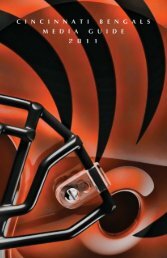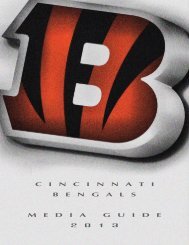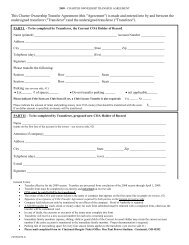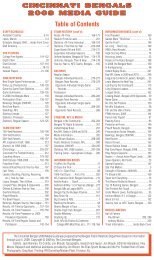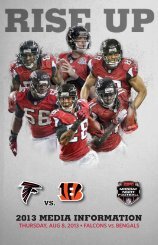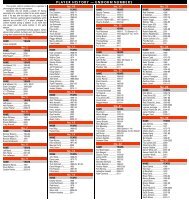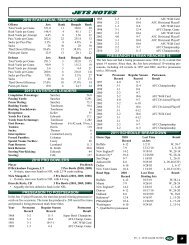Cincinnati Bengals 2009 Media Guide.indb - Bengals Home
Cincinnati Bengals 2009 Media Guide.indb - Bengals Home
Cincinnati Bengals 2009 Media Guide.indb - Bengals Home
Create successful ePaper yourself
Turn your PDF publications into a flip-book with our unique Google optimized e-Paper software.
STADIUM , NFL & MEDIA RECORDS HISTORY 2008 REVIEW COLLEGE FREE AGENTS <strong>2009</strong> DRAFT CHOICES VETERANS ROSTERS STAFF<br />
1981-96 — THE STRIPES<br />
In 1981, the <strong>Bengals</strong> introduced a bold new uniform which was dramatically different than the relatively conservative<br />
designs the team had used since 1968.<br />
Perhaps the most eye-catching distinction of the complete makeover was the team’s new helmet. The helmet<br />
remained orange and retained its<br />
black facemask, but replacing the 1981-96<br />
block-letter “<strong>Bengals</strong>” logotype<br />
were the team’s new signature tiger<br />
stripes. Six black tiger stripes were<br />
placed on the helmet, extending<br />
from one side to the other.<br />
Paul Brown, the team’s founder<br />
who then held the title of Vice<br />
President and General Manager, said<br />
the team wanted a helmet that would<br />
be instantly identifiable with the<br />
<strong>Cincinnati</strong> franchise, something akin<br />
to the Baltimore Colts’ horseshoe<br />
helmet and the San Diego Chargers’<br />
lightning bolt helmet.<br />
“You couldn’t read ‘<strong>Bengals</strong>’ on<br />
our helmet from a distance,” Brown<br />
said at the time. “When you were<br />
far away, it looked like Cleveland’s<br />
helmet.”<br />
The black jersey, the white<br />
jersey and the white pants of the<br />
new uniform featured a black tigerstripe<br />
pattern on top of a wide orange<br />
stripe. On the jerseys, the pattern<br />
appeared on the shoulders. On the<br />
pants, it extended straight down the<br />
full length of each leg.<br />
In addition, the uniform<br />
numbers on the front and back, as<br />
well as those on sides of the sleeves,<br />
were given orange outlines. The<br />
letters on the players’ nameplates,<br />
however, remained solid color<br />
— white on the black jersey, and black on the white jersey — and were not given outlines.<br />
The new uniform was assigned orange-topped socks — white socks with an orange top from the rim to the bottom<br />
of the calf. The team’s primary shoe color remained white.<br />
Interesting facts from this uniform era:<br />
• Sleeves became shorter over time: From when the <strong>Bengals</strong> began play in 1968 through the mid-’80s, the sleeve<br />
length of the jersey was somewhat long by today’s standards, reaching to just above the elbow. In the mid-’80s, sleeves<br />
began shortening over time to the current-day length, reaching only to the lower shoulder or upper biceps. By 1991, all of<br />
the team’s jerseys were made with the shorter sleeves, and the original elbow-length sleeves were never produced again.<br />
• NFL marks were added in 1991: Not pictured here, small NFL shield logos were added to the <strong>Bengals</strong>’ helmets,<br />
jerseys and pants in 1991. All NFL teams added the logos as part of a minor league-wide alteration. On the helmets,<br />
the shields appeared in the rear left area. On the jerseys, it appeared on the front center of the collar. And on the pants,<br />
it was placed on the front left area just below the waist. In 2002, the NFL Equipment logo replaced the shield logos on<br />
the jerseys and the pants, though the shield remained on the helmet. Though they are not included on these 1981-96<br />
uniform illustrations, the shield and equipment logos are incorporated into the 1997-2003 and ’04-present illustrations<br />
on the following two pages, respectively.<br />
• The stripes did not remain entirely the same: The black tiger-stripe patterns on the shoulders of the jersey<br />
and the legs of the pants during this era did not always perfectly match those on the illustrations pictured here. Though<br />
hardly noticeable, the patterns differed slightly from one uniform manufacturer to the next. In most cases, the stripes<br />
were less wide and more numerous. At the time, minor variations of this nature were considered acceptable as long as<br />
they were negligible and did not change the overall appearance of the uniform design.<br />
— 216 —




